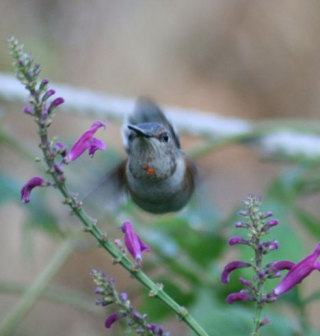It is roughly 2,125 miles from New Orleans to South Whidbey as the crow flies.
Or, in this case, a hummingbird.
In an astonishing feat that has birders buzzing on the airwaves and tearing up the Internet, a Rufous hummingbird that was banded in the Cajun capital has winged its way northwest in search of a mate, some foxglove, a few delphiniums and some sugar water.
Four parts water, one part sugar, to be exact.
“It is impossible for many of us to believe,” said Ann Morgan Campbell from her Peace & Plenty Farm in Clinton. “These little guys normally travel from north to south, not the other way around. We were all shocked.”
The miniature Louisiana traveler is attracting attention from ornithologists and others interested in bird migration nationwide.
Dan Harville has given around 1,000 Rufous hummingbirds numbered bands on Whidbey Island in the last decade. An interesting percentage of the birds are re-traps — returnees given bands in prior years.
In early May, an unusual Rufous was trapped. Since the band it carried was not a number issued by the federal government to Harville, a query to a banders Web site disclosed the bird had been caught in November 2008 in the garden district of New Orleans.
Nancy Newfield, the bander in Louisiana, and garden owner Jan Garvey, had taken pictures of the little fellow and even given it a nickname — Sweet Pea.
This was the first time in banders’ records that a bird first found in the east ended up on a northwestern nesting site.
Newfield termed it, “winning the hummingbird lottery.”
Many of these site-loyal birds return from winters in the south, usually from Mexico or Panama, to the Campbells’ welcoming yard between Langley and Clinton.
“This is a banner year for hummingbirds,” Campbell said. “Consider that 50 little guys will consume a cup of sugar water in 24 hours. We’re having to refill eight cups a day. That’s a lot.”
The farm is a choice site for the little critters that weigh between 3 and 4 grams each, something less than a quarter of an ounce. The Campbells guarantee there is plenty of natural food, sugar water and even provide prime fluff from the dryer for nest makers.
Some hummers stop by the island on their way further north, while others nest here. The bird outflies all other species, and usually gets its way at feeders at the expense of slower, less-maneuverable hummers. The Rufous has the longest migration route of all U.S. hummingbirds — as Sweet Pea convincingly proved.
Jeff VanDerford can be reached at 221-5300 or jvanderford@southwhidbeyrecord.com.



